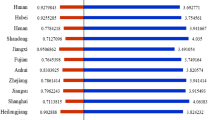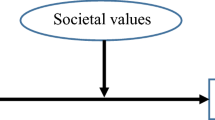Abstract
Traditionally, happiness has been recognized as the result of a positive relationship with one's income level. However, income level may not be the only factor that affects one’s happiness. In this paper, the effects of education and urbanization factors among 67 countries were analyzed by using World Value Survey data and World Bank Indicator. Generally, the urbanization positively affects happiness in the cross-country analysis, but happiness has a negative correlation with education level. More specifically, four geographical trends have been found in this paper. First, if two variables have very low values, the nation's happiness will drop. Second, according to the moderated education ratio (10 < E < 35), East Asia (non-OECD) is found to be happier than Middle East/North Africa. Third, according to the high education ratio (E > 50), East Asia (OECD) has a lower level of happiness than other countries. Lastly, in Europe, urbanization and education are not significant factors in terms of happiness, but the economic level is the most important factor. Those results provide evidence that there are different effects of education/urbanization on happiness in terms of 1) general implication and 2) sub-divided regions (geographic or norm difference).





Similar content being viewed by others
References
Bayliss, D., Olsen, W., & Walthery, P. (2016). Well-being during recession in the UK. Applied Research in Quality of Life, 1-19.
Berkowitz, B. (2015). Chart: What’s the real unemployment rate? CNBC. June 5, 2015. http://www.cnbc.com/2015/06/05/. Accessed August 5, 2015.
Berry, B. J., & Okulicz-Kozaryn, A. (2011). An urban-rural happiness gradient. Urban Geography, 32(6), 871–883.
Brereton, F., Clinch, J. P., & Ferreira, S. (2008). Happiness, geography and the environment. Ecological Economics, 65(2), 386–396.
Chen, W. C. (2012). How education enhances happiness: comparison of mediating factors in four East Asian countries. Social Indicators Research, 106(1), 117–131.
Clark, A. E., & Oswald, A. J. (1994). Unhappiness and unemployment. The Economic Journal, 104(424), 648–659.
Cuñado, J., & de Gracia, F. P. (2012). Does education affect happiness? evidence for Spain. Social Indicators Research, 108(1), 185–196.
Deaton, A. (2008). Income, health, and well-being around the world: evidence from the Gallup World Poll. The Journal of Economic Perspectives, 22(2), 53–72.
Di Tella, R., MacCulloch, R. J., & Oswald, A. J. (2003). The macroeconomics of happiness. Review of Economics and Statistics, 85(4), 809–827.
Diener, E., & Oishi, S. (2000). Money and happiness: income and subjective well-being across nations. Culture and subjective well-being, 185–218.
Easterlin, R. A. (2003). Explaining happiness. Proceedings of the National Academy of Sciences, 100(19), 11176–11183.
Easterlin, R. A., & Sawangfa, O. (2007). Happiness and domain satisfaction: Theory and evidence (No. 2584). Institute for the Study of Labor (IZA).
Ekici, T., & Koydemir, S. (2016). Income expectations and happiness: evidence from British panel data. Applied Research in Quality of Life, 11(2), 539–552.
Fischer, C. S. (1975). Toward a subcultural theory of urbanism. American Journal of Sociology, 80, 1319–1341.
Gerdtham, U. G., & Johannesson, M. (2001). The relationship between happiness, health, and socio-economic factors: results based on Swedish microdata. The Journal of Socio-Economics, 30(6), 553–557.
Hagerty, M. R., & Veenhoven, R. (2003). Wealth and happiness revisited–growing national income does go with greater happiness. Social Indicators Research, 64(1), 1–27.
Han, C. (2012). Satisfaction with the standard of living in reform-era China. The China Quarterly, 212, 919–940.
Hartog, J., & Oosterbeek, H. (1998). Health, wealth and happiness: why pursue a higher education? Economics of Education Review, 17(3), 245–256.
Hu, A. (2015). The changing happiness-enhancing effect of a college degree under higher education expansion: evidence from China. Journal of Happiness Studies, 16(3), 669–685.
Inglehart, R., Foa, R., Peterson, C., & Welzel, C. (2008). Development, freedom, and rising happiness. Perspectives on Psychological Science, 3(4), 264–85.
Jin, M. (2003). Is the Doctoral degree still the white color? : linkage between the dimension of education, job, and the educated unemployment. Educational Development, 137, 95–98.
Layard, R. (2005). Happiness: Lessons from a new science. London: Penguin.
Lin, C.-H. A., Lahiri, S., & Hsu, C.-P. (2014). Happiness and regional segmentation: does space matter? Journal of Happiness Studies, 15(1), 57–83.
Michalos, A. C. (2008). Education, happiness and wellbeing. Social Indicators Research, 87(3), 347–366.
National Science Foundation (NSF). (2008). Despite Frustrations, Americans Are Pretty Darned Happy https://www.nsf.gov/news/news_summ.jsp?cntn_id=111725. Accessed April 1, 2015.
OECD Better Life Index. (2015). Life satisfaction. http://www.oecdbetterlifeindex.org/topics/life-satisfaction/. Accessed April 1, 2015.
Okulicz-Kozaryn, A. (2015). Happiness and place: Why life is better outside of the city. Springer.
Requena, F. (2016). Rural–urban living and level of economic development as factors in subjective well-being. Social Indicators Research, 128(2), 693–708.
Sander, W. (2011). Location and happiness in the United States. Economics Letters, 112(3), 277–279.
Schyns, P. (1998). Crossnational differences in happiness: economic and cultural factors explored. Social Indicators Research, 43(1), 3–26.
Selim, S. (2008). Life satisfaction and happiness in Turkey. Social Indicators Research, 88(3), 531–562.
Theodossiou, I. (1998). The effects of low-pay and unemployment on psychological well-being: a logistic regression approach. Journal of Health Economics, 17(1), 85–104.
Torres-Reyna, O. (2007). Panel data analysis fixed and random effects using Stata (v. 4.2). Data & Statistical Services, Princeton University.
Veenhoven, R. (1991). Is happiness relative? Social Indicators Research, 24, 1–34.
Veenhoven, R., & Choi, Y. (2012). Does intelligence boost happiness? smartness of all pays more than being smarter than others. International Journal of Happiness and Development, 1(1), 5–27.
World Bank. (2015a). GDP per capita (constant 2005 US$). http://data.worldbank.org/indicator/NY.GDP.PCAP.KD. Accessed April 1, 2015.
World Bank. (2015b). Population in Urban Agglomerations of More than 1 Million (% of population). http://data.worldbank.org/indicator/EN.URB.MCTY.TL.ZS. Accessed April 1, 2015.
World Bank. (2015c). School Enrollment, Tertiary (% gross). http://data.worldbank.org/indicator/SE.TER.ENRR. Accessed April 1, 2015.
World Values Survey. (2015). WVS Wave 6 (2010-2014). http://www.worldvaluessurvey.org/WVSDocumentationWV6.jsp. Accessed April 1, 2015.
Yuen, T. W. K., & Chu, W. W. L. (2015). Happiness in ASEAN member states. International Journal of Happiness and Development, 2(1), 69–83.
Author information
Authors and Affiliations
Corresponding author
Ethics declarations
Conflict of Interest
The author declares that he has no conflict of interest.
Rights and permissions
About this article
Cite this article
Kim, D. Cross-National Pattern of Happiness: Do Higher Education and Less Urbanization Degrade Happiness?. Applied Research Quality Life 13, 21–35 (2018). https://doi.org/10.1007/s11482-017-9504-0
Received:
Accepted:
Published:
Issue Date:
DOI: https://doi.org/10.1007/s11482-017-9504-0




